Black Bears
Black Bears: local, spirit, kermode
Ambiguity and hyperbole are rampant on tourism and conservation sites. Despite such sloppy copy, biological and regulative facts are:
• a Spirit Bear is a white black bear anywhere in the Province
• the white black bear (Spirit Bear) is protected from hunting
• kermode DOES NOT imply white; most kermode are black
• kermode DOES NOT mean Spirit Bear
Notes:
a small minority of all black bears have a white colour phase
| kermode is a name given black bears on the north coast where the white phase may reach 10%
| elsewhere, the white phase is present, but less common
| in making it a Provincial symbol, the Government chose to define Spirit Bear as the “non-albino, white colour phase of…Ursus americanus…”, Provincial Symbols
| It’s unlawful…to hunt the white or blue (Glacier) colour phases of the black bear, Hunting and trapping, It's unlawful, item 13.
Reporting: Ministry of Environment biologists work on the theory that all very light–coloured black bears in BC have the same or similar genetic traits. They welcome sighting reports at 1-877-952-7277.
Although there are two bear species around the Lake (and across much of B.C.)—the grizzly bear and the black bear—they are only rarely to be confused.
The common name, black bear, refers to the species, Ursus americanus. Along the southern coast of the Province, all Ursus americanus are indeed black. Yet the name is, perhaps, unfortunate for elsewhere they are not. Local black bears come in a wide range of shades—black, chocolate, cinnamon, and even white—each of which can be seen in the pictures, below. Some researchers have suggested that the lighter shades represent an adaptation to more open forest canopies. This might account the appearance in the dryer portions of the British Columbia Interior, but here in the heavily forested interior wet belt, such animals would likely be a spillover from neighbouring regions. Be that as it may, local bears do come in an eye–pleasing range of shades.
It is the black bear that is the usual autumnal marauder of domestic gardens, fruit trees, and garbage. When the local paper announces that a Conservation Office has killed a problem bear in the community, it is almost always a black bear.
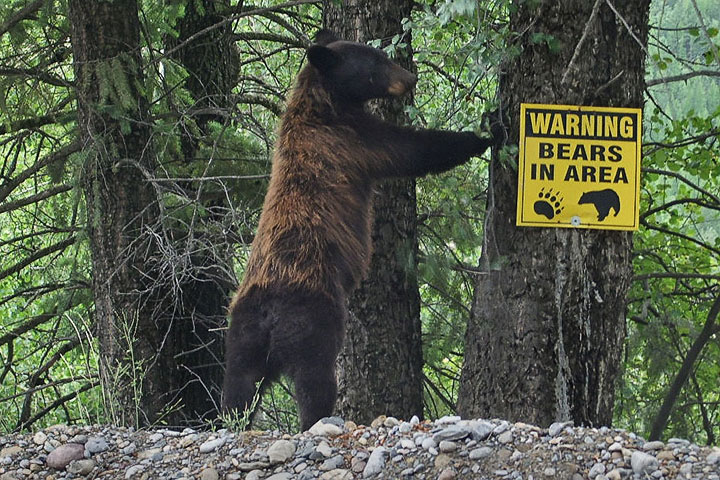 The picture says it all.
The picture says it all.
 Kristina Anderson
Kristina Anderson
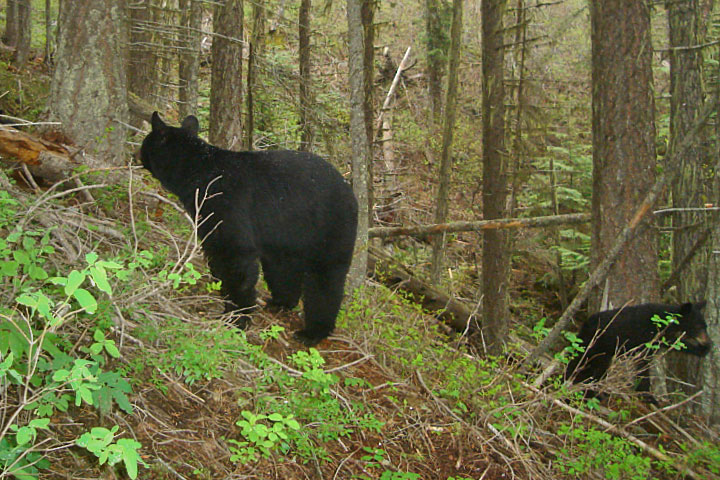
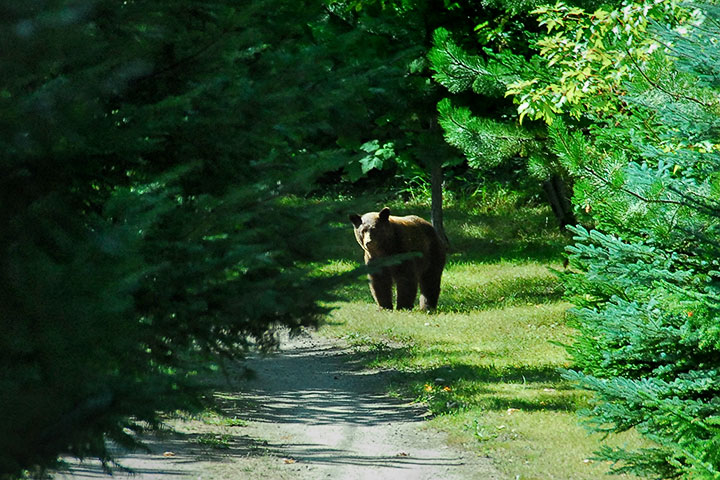 Whether high in the mountains (left), or on a residential driveway (right), the region has black bears.
Whether high in the mountains (left), or on a residential driveway (right), the region has black bears.
 This black bear, peering from the Stygian forest, is a classic example of its species—a white chest patch on an otherwise black coat. And while in the coastal regions of British Columbia, all black bears are like this one—black—around here, the species comes in a variety of shades. The well defined white V on the bear’s chest is not actually very common, maybe occurring in as little as 10% of the population.
This black bear, peering from the Stygian forest, is a classic example of its species—a white chest patch on an otherwise black coat. And while in the coastal regions of British Columbia, all black bears are like this one—black—around here, the species comes in a variety of shades. The well defined white V on the bear’s chest is not actually very common, maybe occurring in as little as 10% of the population.
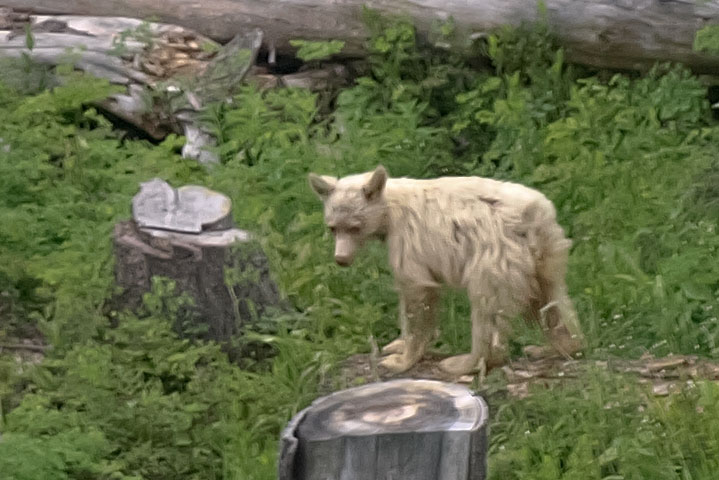 This is a white black bear. Albeit uncommon locally, it is one of the many colour phases to be found in this area. This is a Spirit Bear and it is protected from hunting (see the box, above).
This is a white black bear. Albeit uncommon locally, it is one of the many colour phases to be found in this area. This is a Spirit Bear and it is protected from hunting (see the box, above).  Doug Thorburn
Doug Thorburn
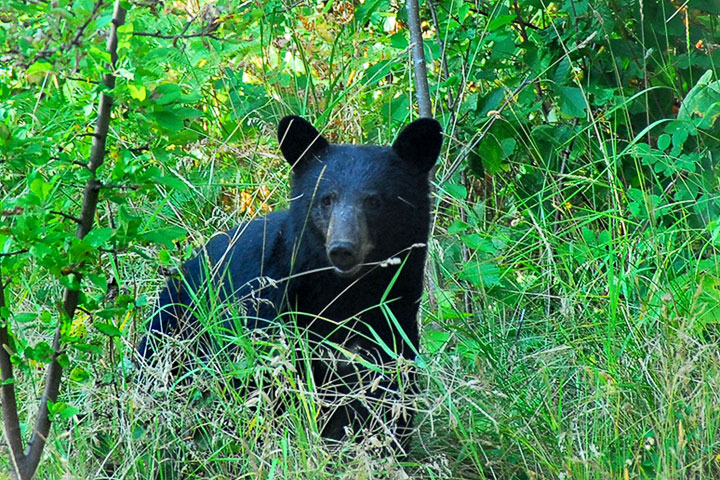 The black bear is abundant in the mountains around the Lake. However, it is most likely to be seen near the lakeshore in the late summer through the fall when it seeks fruit-covered trees.
The black bear is abundant in the mountains around the Lake. However, it is most likely to be seen near the lakeshore in the late summer through the fall when it seeks fruit-covered trees.
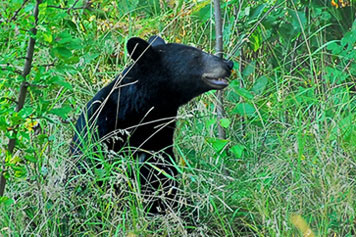 The black bear has a dog-like face, with a straight snout and very slightly pointed ears.
The black bear has a dog-like face, with a straight snout and very slightly pointed ears.
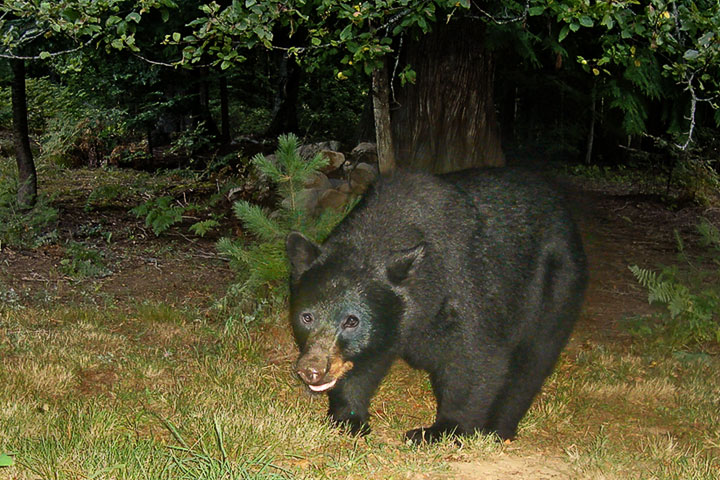 The shoulder hump seems to suggest a Grizzly Bear, but this merely results from the bear’s awkward stance: consider it a black bear with bad posture. It is visiting an apple tree in early September. After shaking the tree and knocking some apples onto the ground, it wandered off without having eaten them all. A few hours later, a White-tailed doe came by and helped itself to the apples the bear had left.
The shoulder hump seems to suggest a Grizzly Bear, but this merely results from the bear’s awkward stance: consider it a black bear with bad posture. It is visiting an apple tree in early September. After shaking the tree and knocking some apples onto the ground, it wandered off without having eaten them all. A few hours later, a White-tailed doe came by and helped itself to the apples the bear had left.
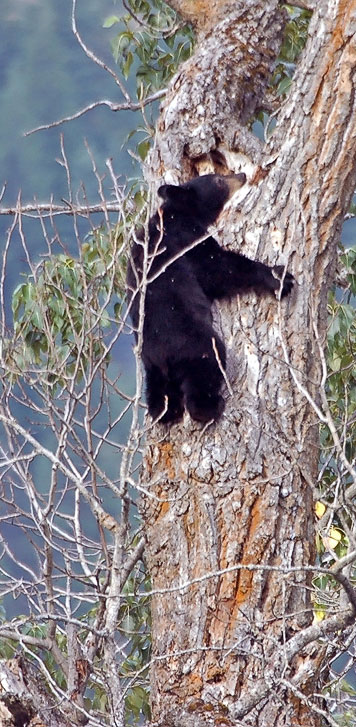 Small black bears and cubs will climb a tree to show submission to a large male. In the winter black bears often use trees as denning sites, but this is July. So, why did the bear scale this black cottonwood? It did not explain its actions.
Small black bears and cubs will climb a tree to show submission to a large male. In the winter black bears often use trees as denning sites, but this is July. So, why did the bear scale this black cottonwood? It did not explain its actions.  LVD
LVD
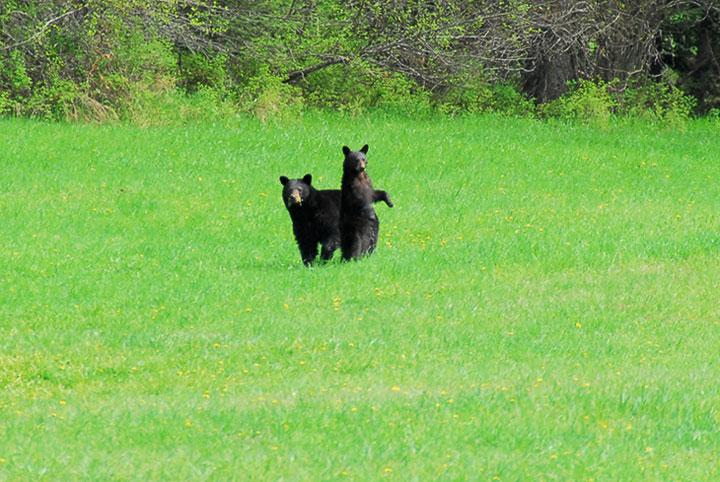 A sow and its cub feast on dandelions in early May. Cubs are born in January or February, during hibernation. This cub is standing, not as much to get a better view (they don’t have good eyesight), but to sniff the breeze higher up. It may be trying to detect the presence of the photographer.
A sow and its cub feast on dandelions in early May. Cubs are born in January or February, during hibernation. This cub is standing, not as much to get a better view (they don’t have good eyesight), but to sniff the breeze higher up. It may be trying to detect the presence of the photographer.
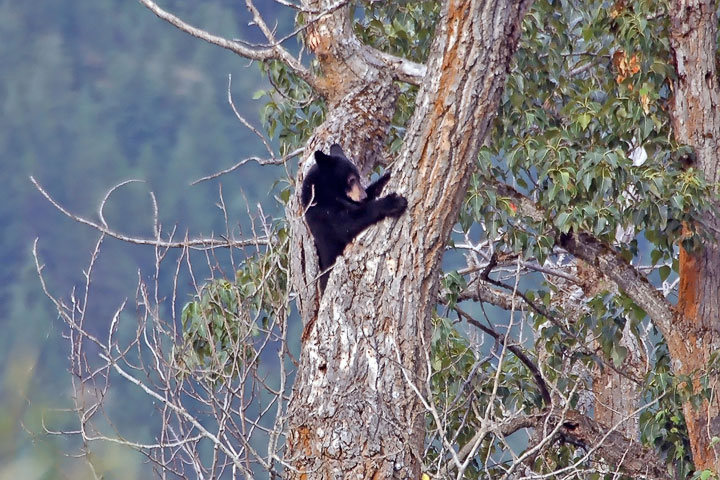 The same bear as in the picture to the left has found a comfortable notch.
The same bear as in the picture to the left has found a comfortable notch.  LVD
LVD
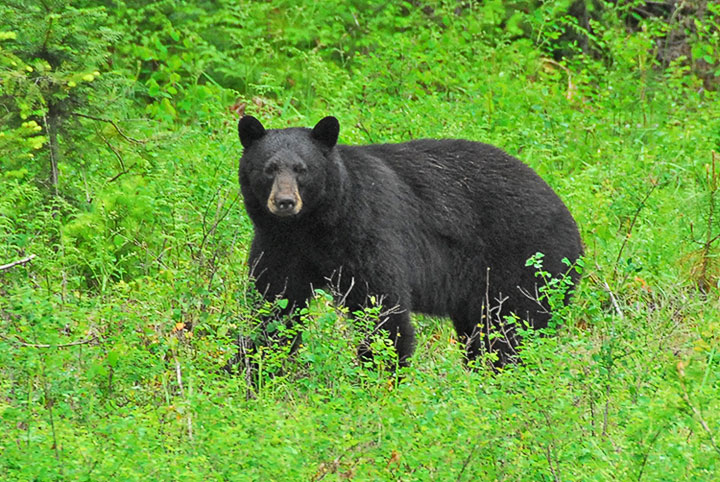 In June, the bears leave the valley bottoms and head into the mountains following the berries which spring up as snows recede.
In June, the bears leave the valley bottoms and head into the mountains following the berries which spring up as snows recede.
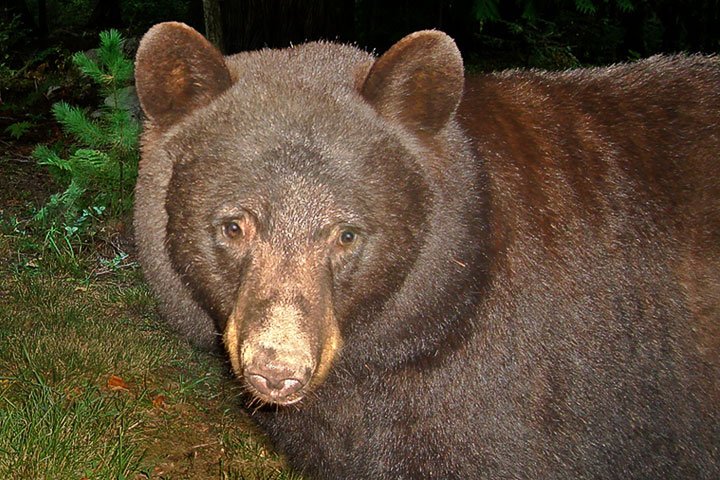 This soulful-looking black bear is a rich chocolate brown, as are many of its species around the Lake.
This soulful-looking black bear is a rich chocolate brown, as are many of its species around the Lake.
 Hmm, I think it may be time to back away.
Hmm, I think it may be time to back away.
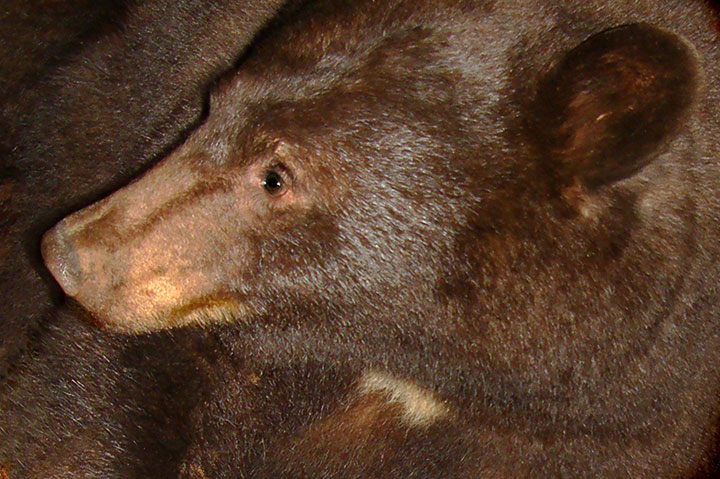 As far as I can tell, the black bears around here are a really contemplative bunch: just look at the thoughtful expression. This one passed by at the beginning of November; I suspect a pending hibernation is on its mind.
As far as I can tell, the black bears around here are a really contemplative bunch: just look at the thoughtful expression. This one passed by at the beginning of November; I suspect a pending hibernation is on its mind.
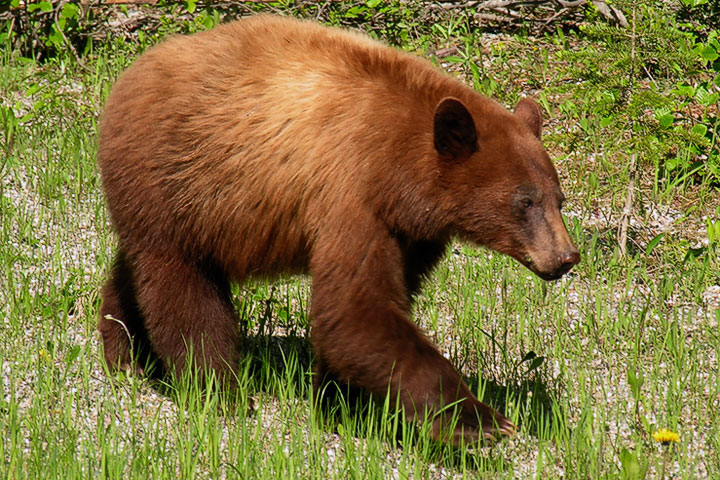 Although the cinnamon colour of this bear tempts one to identify it as a grizzly bear, its lack of a prominent shoulder hump reveals it as a black bear.
Although the cinnamon colour of this bear tempts one to identify it as a grizzly bear, its lack of a prominent shoulder hump reveals it as a black bear.
This bear was aware that I was standing nearby, but it treated me with indifference. Its nonchalance was a far cry from the behaviour of a deer I saw a short time later.
 A staple of the black bear diet is a succulent plant. Early in the season they particularly favour munching on dandelions.
A staple of the black bear diet is a succulent plant. Early in the season they particularly favour munching on dandelions.
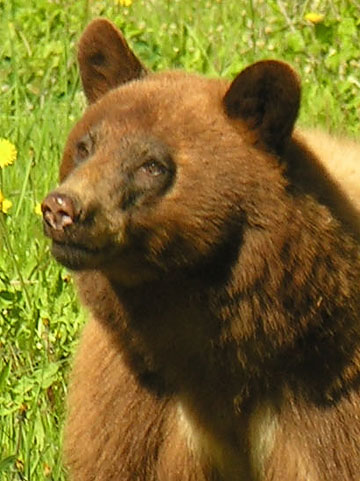 The whitish patch (somewhat in shadow here) on the chest is a giveaway.
The whitish patch (somewhat in shadow here) on the chest is a giveaway.
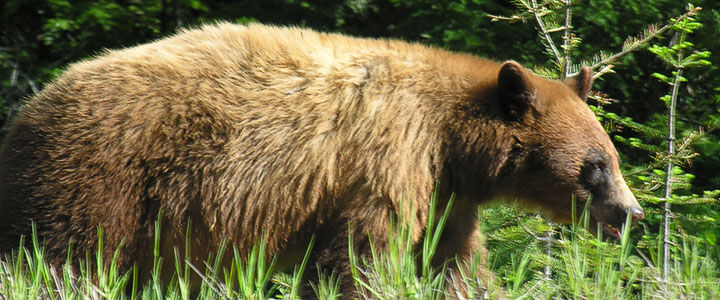 Although a bear can move very rapidly when it chooses, this one was but lumbering.
Although a bear can move very rapidly when it chooses, this one was but lumbering.
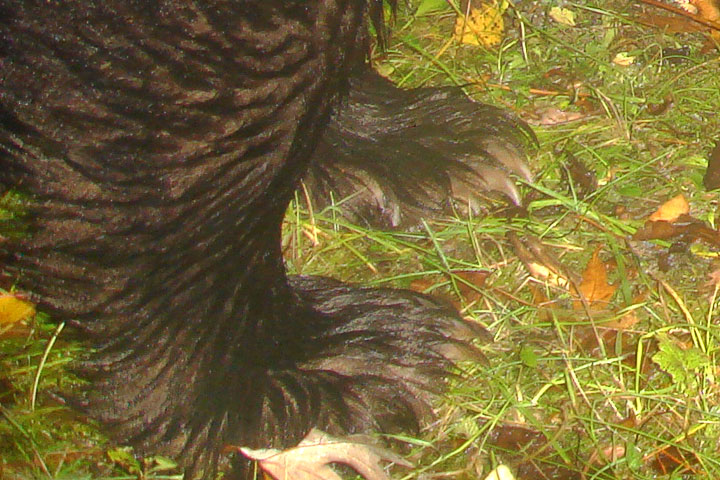 The black bear’s claws are not as long as those of the Grizzly Bear, but they are more strongly curved, an advantage when climbing trees.
The black bear’s claws are not as long as those of the Grizzly Bear, but they are more strongly curved, an advantage when climbing trees.
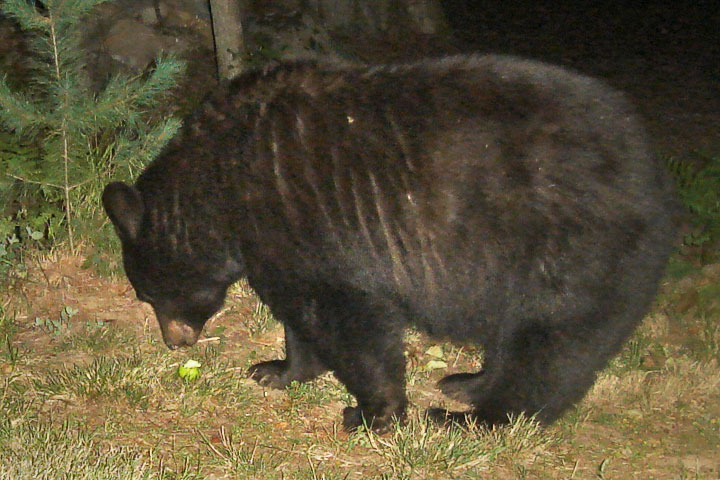 After a summer of feeding higher in the mountains, bears returned to valley bottom to scrounge for fruit.
After a summer of feeding higher in the mountains, bears returned to valley bottom to scrounge for fruit.
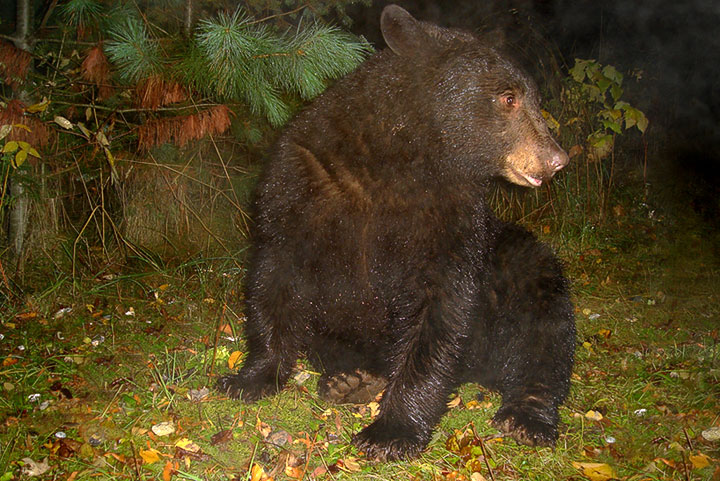 Now and then, one stops roaming and sits down for a while. This lad is a yearling: he is about twenty months old.
Now and then, one stops roaming and sits down for a while. This lad is a yearling: he is about twenty months old.
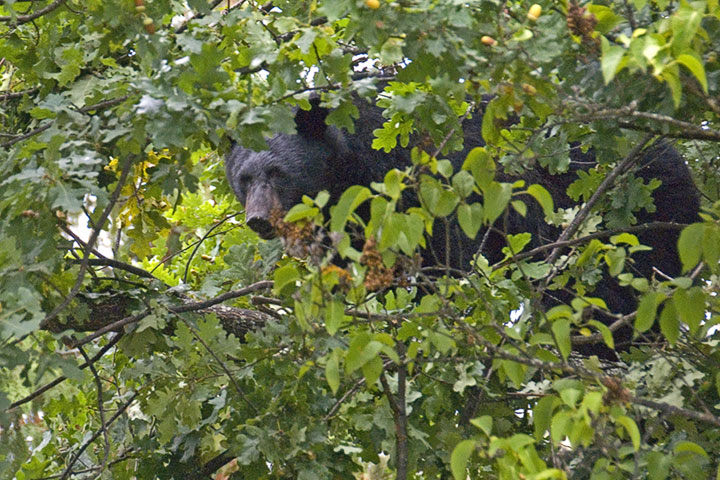 It is October and this black bear is fattening up for the winter on acorns. Oak trees are not native to the Kootenays, but cultivars have been planted at places along the lakeshore and bears have discovered them.
It is October and this black bear is fattening up for the winter on acorns. Oak trees are not native to the Kootenays, but cultivars have been planted at places along the lakeshore and bears have discovered them.
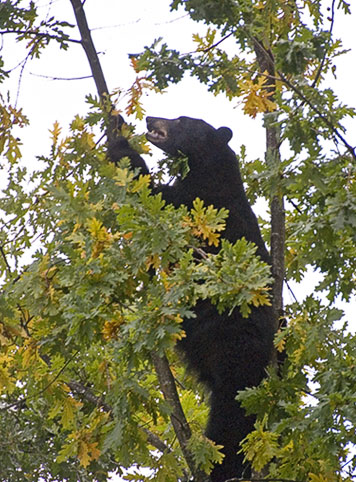 A telephoto shot of the black bear eating acorns high in an oak tree.
A telephoto shot of the black bear eating acorns high in an oak tree.
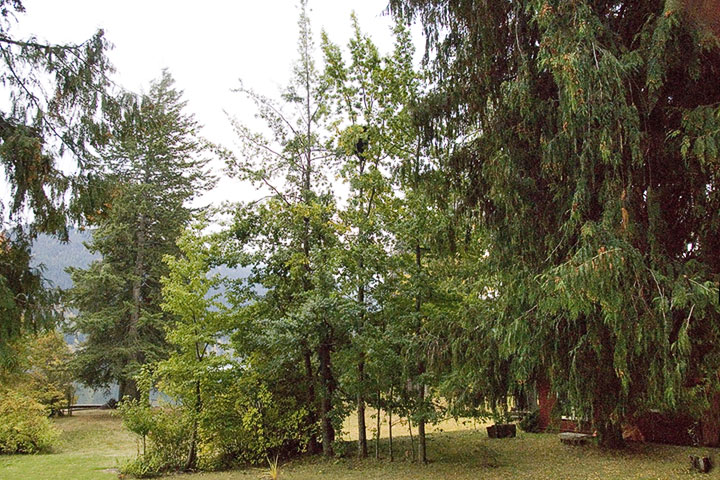 High in the central tree, there is a black dot; this is a bear. It has climbed this oak tree to eat the acorns. A moment later, the picture on the right was taken of the same bear.
High in the central tree, there is a black dot; this is a bear. It has climbed this oak tree to eat the acorns. A moment later, the picture on the right was taken of the same bear.
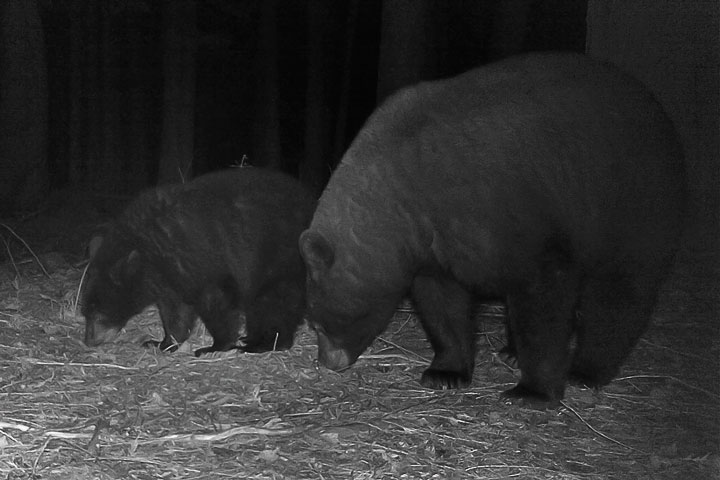 A sow and cub are recorded by an infrared camera as they forage along a well-worn wildlife trail in October.
A sow and cub are recorded by an infrared camera as they forage along a well-worn wildlife trail in October.
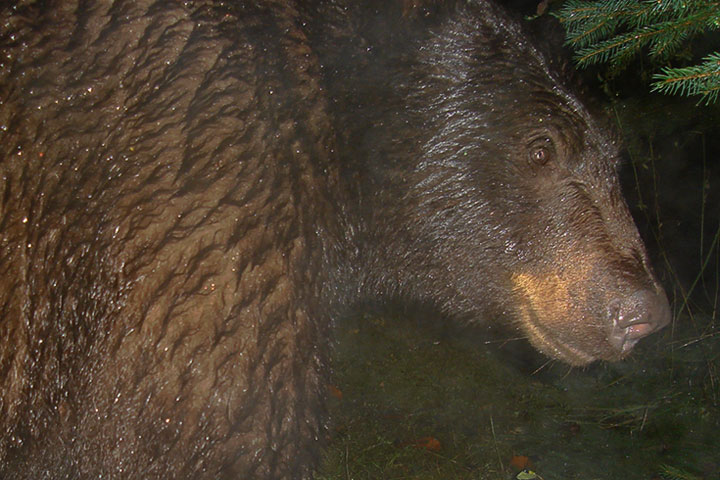 The black bear is a solitary animal. This rain–soaked, dark–chocolate, bear is travelling alone along a well worn path in the early evening.
The black bear is a solitary animal. This rain–soaked, dark–chocolate, bear is travelling alone along a well worn path in the early evening.
Information from BC Ministry of the Environment: Black Bears in BC; information from Bear Smart: The Bear Facts.
![]()